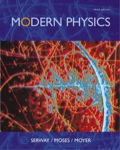
Concept explainers
(a)
The threshold for production of strange particles in the reaction
(a)
Answer to Problem 14P
The threshold for production of strange particles in the reaction
Explanation of Solution
Consider the reaction,
Write the expression for the threshold for production of strange particles in the reaction.
Here,
Conclusion:
Substitute
Therefore, the threshold for production of strange particles in the reaction
(b)
The threshold for production of strange particles in the reaction
(b)
Answer to Problem 14P
The threshold for production of strange particles in the reaction
Explanation of Solution
Consider the reaction,
Write the expression for the threshold for production of strange particles in the reaction
Conclusion:
Substitute
Therefore, the threshold for production of strange particles in the reaction
Want to see more full solutions like this?
Chapter 15 Solutions
EBK MODERN PHYSICS
- A pion at rest (m = 273me) decays to a muon (m = 207me) and an antineutrino (mp 0). The reaction is written + v. Find (a) the kinetic energy of the muon and (b) the energy of the antineutrino in electron volts.arrow_forwardThe average lifetime of a pi meson in its own frame of reference is 2.6 × 10−8 s. If the meson moves with a speed of 0.95c, what is (a) its mean lifetime as measured by an observer on Earth and (b) the average distance it travels before decaying, as measured by an observer on Earth?arrow_forwardDetermine whether or not strangeness is conserved in the following decays and reactions. (a) ^0 → p + π− (b) π− + p → ^0 + K0 (c) P- + p → 0 (d) π− + p → π− + Σ+ (e) Ξ− → ^0π−0 → p + π−arrow_forward
 Modern PhysicsPhysicsISBN:9781111794378Author:Raymond A. Serway, Clement J. Moses, Curt A. MoyerPublisher:Cengage Learning
Modern PhysicsPhysicsISBN:9781111794378Author:Raymond A. Serway, Clement J. Moses, Curt A. MoyerPublisher:Cengage Learning Physics for Scientists and Engineers with Modern ...PhysicsISBN:9781337553292Author:Raymond A. Serway, John W. JewettPublisher:Cengage Learning
Physics for Scientists and Engineers with Modern ...PhysicsISBN:9781337553292Author:Raymond A. Serway, John W. JewettPublisher:Cengage Learning Principles of Physics: A Calculus-Based TextPhysicsISBN:9781133104261Author:Raymond A. Serway, John W. JewettPublisher:Cengage Learning
Principles of Physics: A Calculus-Based TextPhysicsISBN:9781133104261Author:Raymond A. Serway, John W. JewettPublisher:Cengage Learning Physics for Scientists and Engineers: Foundations...PhysicsISBN:9781133939146Author:Katz, Debora M.Publisher:Cengage Learning
Physics for Scientists and Engineers: Foundations...PhysicsISBN:9781133939146Author:Katz, Debora M.Publisher:Cengage Learning Physics for Scientists and Engineers, Technology ...PhysicsISBN:9781305116399Author:Raymond A. Serway, John W. JewettPublisher:Cengage Learning
Physics for Scientists and Engineers, Technology ...PhysicsISBN:9781305116399Author:Raymond A. Serway, John W. JewettPublisher:Cengage Learning




